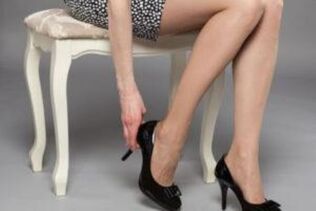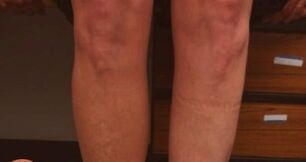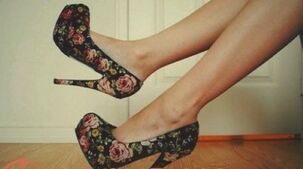What is this disease?
Varicose veins of the lower extremities are a very dangerous disease that can be fatal. This is a pathological damage to the organs of the circulatory system. With the complication of the disease, an irreversible process of stretching and stretching of the veins is observed.Nodules begin to form in the capillaries that block normal blood flow. With varicose veins, the walls of the vessels dilate so much that the function of the valves deteriorates. For this reason, the blood begins to stop in the legs.The disease mainly affects people aged 30 to 40 years.
Growth reasons
The causes of this disease can be very different. Among them are:
- hereditary factors (possible congenital abnormality or weakness of the venous cells).
- is more common in women (in women, the disease is much more common due to the use of hormonal drugs, the risk also increases due to delayed delivery).
- increased pressure in the veins (this is due to an inactive lifestyle, the presence of excess weight).
- the presence of neuroendocrine changes? mechanical obstructions to normal blood circulation (this can be facilitated by constant compression of the limbs).
- the presence of allergic reactions.
- changes in the immune system.
- disorders in the function of the valves of the venous system.
- this pathology may begin to develop due to cellulite or dermatitis.
Before starting treatment, it is necessary to determine the root cause of the disease. An experienced phlebologist will help you do this.
Symptoms and manifestations of internal varicose veins
It is important to see a doctor in time,if varicose veins appear in the lower extremities. The symptoms of this disease at the very beginning stage of varicose veins will be the following:

- there is swelling of the limbs by the end of the day(this symptom occurs in the ankles and feet, swelling may also occur in the lower half of the lower leg).
- the patient develops a feeling of heaviness in the calf muscles(a feeling of bloating occurs after a long walk or posture, this may occur after a long stay in a sitting position).
A feature of this disease is the fact thatafter rest, all symptoms disappear without a trace. It also shrinks after a long rest.
During the gradual development of varicose veins, the following symptoms will begin to appear:
- moderate pain begins to appear in the calf muscles, such pains are dull and aching
- local burning sensation and fatigue.
- excessive dryness of the skin occurs, pigment spots begin to appear and the skin hardens.
- convulsions occur very often at night.
- spider veins begin to appear on the skin.
- the internal veins in the legs, pictured below, begin to expand significantly, looking like bunches of grapes.
- it is possible for thin wounds to form that heal over a long period of time.
Important!Early treatment of this disease for the patient can cause some complications. In some cases, a fatal outcome is possible.

After a period of time, eczema and food ulcers begin to appear. Such symptoms easily turn into gangrene. All of these can cause limb amputation, rot or death.
The most dangerous consequence is the appearance of a clot, with its subsequent separation. This becomes the death of the patient.
Symptoms and treatment of latent varicose veins is the question that most concerns patients.
Treatment methods
Treatment for varicose veins is performed conservatively and immediately. The treatment of the internal veins in the legs, whose symptoms can manifest in different ways, is carried out only after a preliminary diagnosis.The following techniques may be used:
- compression?
- sclerosis?
- drugs?
- surgery.
Compression methodshelp treat the disease in its early stages. This method of treatment involves the daily use of special compression underwear.
In case of sclerosis, the vein is blocked. This is due to the introduction of sclerotherapy formulations into it. After such actions, the blood can easily move through the capillaries without difficulty.
Conservative treatment is effective only if the first signs of the disease appear. Of the drugs, bentonica is prescribed to patients. They help strengthen the walls of blood vessels as much as possible.
Self-healing of internal varicose veins is prohibited, the symptoms of which can be mild and vice versa.
Prevention
In order to prevent the formation of varicose veins, it is necessary to know the main causes of this disease and to prevent their development.The precautionary measures are as follows:
- Continuous physical activity is required (People who lead an inactive lifestyle are much more susceptible to the disease. Take breaks from time to time, get up and exercise so that the blood circulates normally. )
- When sitting, it is forbidden to cross your legs.
- give up all bad habits.
- pay attention to your diet, discard very fatty and salty.
- to take therapeutic measures in relation to endocrine diseases, lead to the development of varicose veins.
- use only loose shoes without compression (it is necessary to ensure free circulation of blood, as well as to limit yourself to shoes with heels).
- swim in the sea, but it is necessary to eliminate solar overheating.
Conclusion
It should be noted that if at least one symptom of this disease occurs, it is necessary to consult a specialist urgently. The doctor will prescribe diagnostic procedures and suggest the appropriate treatment. Delay threatens complications.
From the above, we can summarize that latent varicose veins are a very dangerous disease that can have side effects. For this reason, if at least one symptom occurs, it is necessary to seek medical help. Only a specialist will be able to choose the necessary treatment.
Internal varicose veins in the legs: symptoms and treatment The geography of the spread of varicose veins covers almost all countries of the world, it is one of the oldest diseases known to mankind. According to medical statistics, varicose veins of the lower extremities and pelvic organs occur in 15-17% of the population. Today, patients with this diagnosis make up about 4% of all patients in surgical clinics. According to scientists, this disease is a kind of payment to humanity for the ability to walk upright. Let's look at what internal varicose veins are, the main symptoms of the disease and the effective treatment.Explanation of the onset of the disease
The development of internal varicose veins in the legs is one of the most dangerous types of the disease, which is manifested in the pathological expansion of blood vessels located deep under the skin in the tissues.
This disease, unfortunately, often affects young people of working age and in women, the symptoms are much more common. The internal varicose veins of the legs are often accompanied by external ones in the form of strongly protruding veins with a strong cyanotic hue.
Dilation of the venous vessels in the legs can be an independent pathology, but it is most often caused by other diseases, and therefore in modern medicine it is common to divide the varicose veins into primary and secondary. The cause of primary varicose veins of the deep veins of the legs is the weakness of the venous wall or its functional pathologies. These reasons also cause varicose veins of the pelvic organs. Among the main causes of the disease are:These varicose vein symptoms make treatment difficult. The appearance of varicose veins in the legs is shown in many photos from medical sites.
- Pregnancy.
- Overweight, morbid obesity.
- Prolonged load on the lower extremities, continuous work on the legs or associated with constant lifting.
- Hereditary or congenital weakness of the connective tissue of various organs.
- Prolonged walking in high heels and wearing socks with tight elastic bands.
- In elderly patients, the formation of internal varicose veins can be caused by hormonal changes in the body.

The development of secondary internal varicose veins is a consequence of changes in the process of venous outflow in various diseases:
- Post-thrombophlebitis syndrome.
- Deep vein damage.
- Tumors of organs of various etiologies.
- Injuries to limbs and other organs.
Treatment of primary and secondary varicose veins is different.
Main features
The consequences of a timely undetected internal varicose veins can be very serious, therefore, it is necessary to pay attention to the first symptoms of the disease, especially because, compared to other forms of the disease, they manifest very clearly visually. The main symptoms of internal varicose veins of the lower extremities are manifested in the following:
- The pain in the calf muscles is very strong, often unbearable so much that the patient is forced to take regular intense pain medication. These symptoms are the reason for immediate medical attention. The venous pattern at the lower extremities of the thigh area becomes intense, the vessels become very convex and tubular, easily recognizable by palpation. The venous pattern acquires a cyanotic color, sometimes turning black, sometimes reddish-red.
- The lower extremities swell a lot and the swelling does not decrease after a night's sleep.
- At night, after a working day on his feet, the patient develops frequent cramps in the calf muscles.
All these symptoms significantly worsen the patient's quality of life and require immediate medical attention, sometimes only vein surgery.

Clinical presentation
The severity of the symptoms of internal varicose veins depends on the stage of the disease.
In the initial stage, no pathological changes are detected in the walls of blood vessels, patients have swelling of the legs by the end of the working day and heaviness in the legs, but after a night's rest, these unpleasant sensations disappear.
Some patients have mild dizziness, this stage of the disease is called "intradermal varicose veins". If treatment is started at this stage of the disease, then the prognosis is very favorable, as the valve system of the veins has not changed and is still facing the load, the pathological symptoms will disappear quickly.
In the second stage of the disease, the swelling of the lower extremities becomes permanent, patients complain of constant heaviness in the legs and increased fatigue. Manifestations of internal varicose veins at this stage of the disease are also indicated by persistent cramps of the calf muscles and cold limbs.
A photo in medical publications shows that blood vessels begin to appear on the skin on the inside of the thigh, but their areas of appearance are not painful to the touch. At this stage, the formation of varicose veins begins, there may be bleeding from them.
These symptoms intensify very quickly and if there is no cure, the disease progresses to the next stage.
The third stage of varicose veins has already been visually defined, this can be seen in the photo from various medical sources.
Varicose veins and muscle enlargements caused by severe circulatory disorders are already well established under the skin of calves and inner thighs.At this stage, in addition to the appearance of knots, the patient has fragility and hair loss, dry skin, persistent cramps in the calf muscles.
The fourth stage of the disease already involves serious complications (bleeding, ulcers, etc. ), which can be fatal. You need to start treating the disease immediately, without expecting terrible symptoms.
Complications
These include the following:
Trophic ulcers of the skin of the feet.
This is a very painful complication for the patient, as food ulcers heal very slowly and the patient experiences constant itching and burning in their location.
The photo clearly shows that the ulcers have a round shape, bright colors and with different types of secretions: purulent, hemorrhagic or serous discharge. They appear on the calves and inside the thigh.
With proper and timely treatment, the appearance of scars begins, but if there is no help or no special, the patient can develop gangrene followed by amputation of the limb. Death is also possible.
Traumatic bleeding.
Massive bleeding may be due to rupture of a blood vessel due to thinning of the venous wall under a constant increase in blood pressure or due to a small injury. This syndrome is especially dangerous because bleeding can lead to the death of the patient.
Thrombosis is a consequence of congestion and inflammation in the veins of the lower extremities. Thrombosis can be manifested visually only in swelling of the legs and severe pain in it.
Thrombosis is very dangerous for the patient's life and requires urgent hospitalization and treatment, as it can cause heart attack and obstruction of the pulmonary artery in the patient.With the formation of external venous nodes, thrombosis is accompanied by severe pain in the area of thrombus formation, tenderness of the vein to palpation and fever in the area of thrombosis.

Principles of Treatment
It is very difficult to treat internal varicose veins in the legs and the effectiveness of treatment depends largely on the stage of the disease.
The general principles of treatment of the disease include the normalization of hormonal levels, the optimization of physical activity and the observance of diet.
If the patient is obese, it is necessary to develop a method of weight loss and monitor its implementation. To normalize the vascular tone of the lower extremities, the use of compression tights is recommended.
The most effective method of treatment is surgery, the technique of which is well developed in modern surgery. A possible complication of surgery is venous bleeding, but the risk is low.
If for some reason surgery is impossible, for example, if the patient is afraid that life-threatening bleeding will start, treatment is medically performed using the following groups of drugs:
- Antiplatelet agents - to thin the blood and prevent blood clots.
- Phlebotonics - to normalize blood circulation and prevent edema.
- Nitrates - to relieve pain symptoms.
- Vascular protectors - to normalize vascular tone.
- Non-steroidal anti-inflammatory drugs - to reduce the chance of platelet adhesion and to relieve pain.
Many sources recommend the treatment of varicose veins with folk remedies, on the Internet you can find many photos of calves and thighs in "before" and "after" style on sites that advertise traditional medicine and guarantee 100% recovery. Doctors are very wary of such drugs and warn that they can only be used as part of a complex treatment.
Internal varicose veins of the lower extremities are a serious systemic disease that requires timely and specialized treatment. The first disturbing symptoms can not be ignored. The sooner the patient seeks medical attention, the more effective the treatment will be.Main characteristic symptoms
Experts distinguish three stages of varicose veins of the lower extremities - compensation, under-compensation and compensation. Respectively corresponds to a light, medium and severe course. In some cases, more than a year passes between the onset of the disease and the onset of symptoms.There is almost nothing to worry about during compensation. During a strong overwork of the body, small pains in the extremities are possible. Peripheral swelling that subsides after sleep.
Some people report feeling like spiders or gooseberries crawling under their feet. This is due to reduced blood flow and food tissue.
The deep vein valve device is largely intact. There are usually no visible superficial changes in the skin and veins.
Compensation is characterized by a more serious clinical picture. Pains occur more and more often. They wear intense pain on the dagger. An ordinary brushstroke can be a whole lot of hard work.
Patients cannot walk normally. The usual shopping trip is located in the latter.
The legs swell to a great extent, exceeding the normal volume of the foot by one and a half times. Often, such swelling does not subside even after prolonged sleep. Traces of depressed fingers remain on the shins. Many people experience cramps in the calf muscles.
During decompression, there are often signs of bleeding, thrombophlebitis and thrombosis, food ulcers.
Complications arising from the development of internal varicose veins
The most common complication of varicose veins is bleeding. If not diagnosed early, it can be fatal. Even minor bleeding from varicose veins of the lower extremities can cause irreparable damage. Stopping such a defect with a conventional pressure bandage often fails. Many surgeons come to ligate the vessels or coagulate them.
The second most common complication is the addition of infections with the development of food ulcers. Due to the reduction of food tissue, abscesses do not heal for a long time, a chronic purulent focus is created.
Accompanied by general intoxication of the body, feverish fever, intense sweating. Such wounds take a long time to heal. It depends on the degree of nutritional tissue disorder and the depth of the lesion.
Ulcers should not be tied often, as this can cause crusts to form and lead to open wound reconstruction.The next most common complication is deep vein thrombosis. With poor motor function, the blood stops flowing and the risk of blood clots forming increases, which in turn can cause a pulmonary embolism.
Vascular surgeons are more afraid of a floating thrombus, as it is the distal part that tends to rupture and lead to a stroke.
Treatment methods
The treatment of internal varicose veins of the lower extremities takes place in various stages.
Medication is the most popular direction, which can be used in all stages of varicose veins, as well as for the prevention of vascular problems.
The basis of conservative treatment is the intake of bentonite drugs. They help strengthen the vascular wall, increase its elasticity and reduce blood stagnation. It is best to apply them internally and externally to the site of injury.
There are many categories of underwear used for different stages of the disease. Many models will be able to satisfy the individual desire of each person, I have only positive reviews.
When worn with clothing, do not cause discomfort or irritation.
Proper and balanced diet is one of the important points in the treatment of varicose veins of the lower extremities. It is necessary to radically limit yourself to the consumption of salt and large amounts of fluids. The use of natural drinks and fruit juices is desirable.
Diet should strictly correspond to human energy consumption and contain fewer calories in order to avoid being overweight. You should limit yourself to eating fatty and fried foods, spicy and sour. You should prefer vegetables and fruits. Include in the diet seafood, fermented milk dishes and products containing digestible carbohydrates.
In case of ineffectiveness of conservative treatment methods, they resort to surgical techniques. These include both invasive and minimally invasive treatments.
Prevention of pathology
Knowing the dangers of varicose veins, many want to prevent it from appearing in advance. To do this, you do not need to follow strict rules, you just need to return your lifestyle to normal.
The main precaution is regular physical activity.
You can do exercise, yoga, walking, swimming or even dancing to reduce the risk of many diseases.
In addition, it is recommended that you completely or at least partially give up bad habits. It is recommended that you adjust your workout and rest schedule to give your body at least a short break.
It would be helpful to adjust your diet to exclude fried, fatty, smoked, pickled, overly spicy or salty foods. You need to eat more vegetables and fruits.
Regular contrast showers and relaxing foot baths are good precautions.













































